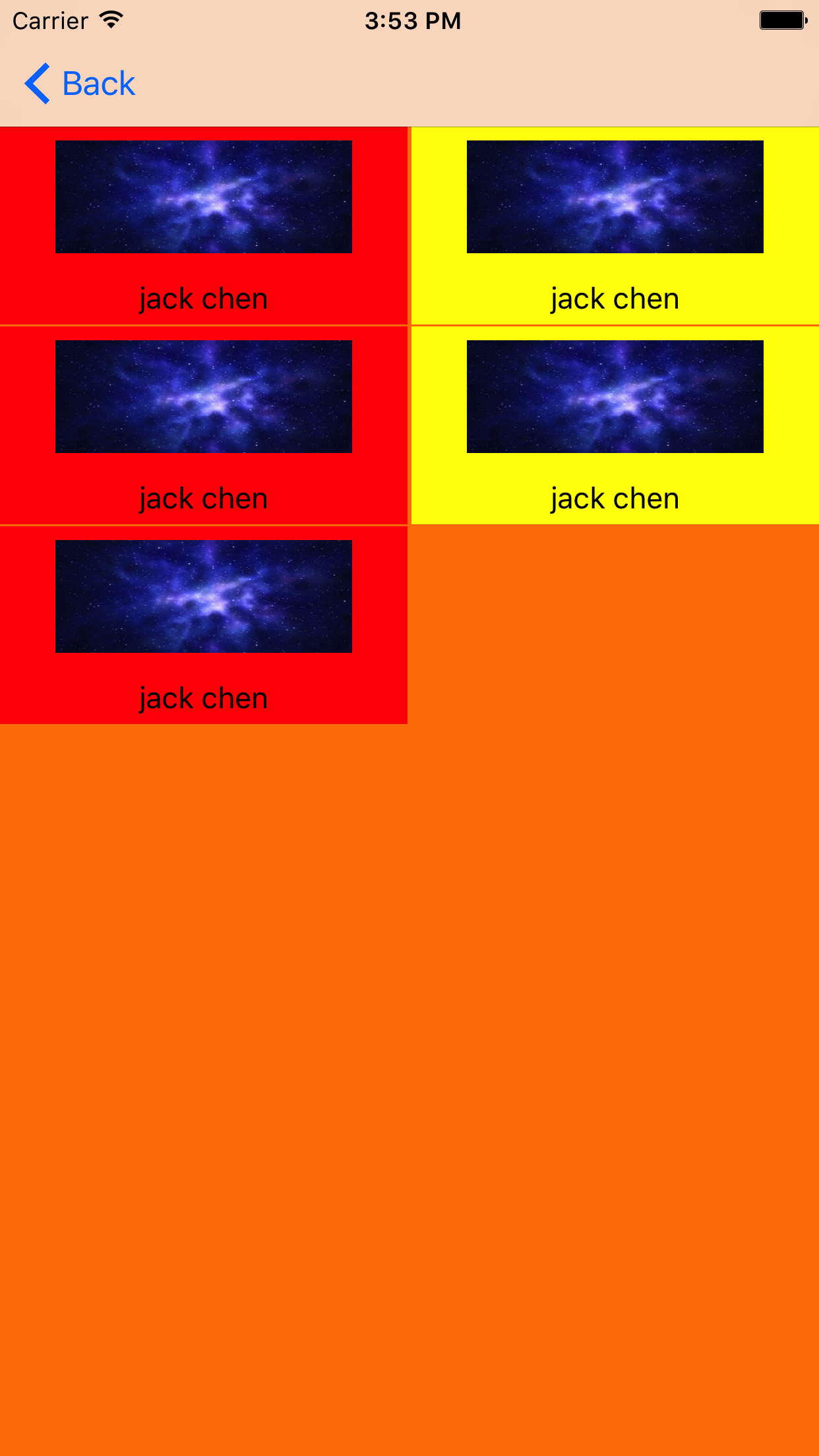具体代码如下:
1、声明
var hCollectionView:UICollectionView? var layout:UICollectionViewFlowLayout? let courser = [ ["name":"jack chen","pic":"1.jpeg"], ["name":"jack chen","pic":"1.jpeg"], ["name":"jack chen","pic":"1.jpeg"], ["name":"jack chen","pic":"1.jpeg"], ["name":"jack chen","pic":"1.jpeg"] ]
2、创建流布局,并初始化cellevtionView
// 设置布局流格式 layout = UICollectionViewFlowLayout() layout?.itemSize = CGSize(self.view.frame.width/2-1,height:100) // 列间距,行间距,偏移 layout?.minimumInteritemSpacing = 1 //列间距 layout?.minimumLineSpacing = 1 //行间距 // layout?.sectionInset = UIEdgeInsets(top:5,left:0,bottom:0,right:0) self.hCollectionView = UICollectionView.init(frame: CGRect(x:0,y:0,kScreenWidth,height:kScreenHeight), collectionViewLayout: layout!) self.hCollectionView?.delegate = self self.hCollectionView?.dataSource = self self.hCollectionView?.register(UINib.init(nibName: "hCell", bundle: nil), forCellWithReuseIdentifier: "hCell") self.hCollectionView?.backgroundColor = UIColor.orange //collectionview的偏移量 // self.hCollectionView?.contentInset = UIEdgeInsets(top:5,left:0,bottom:5,right:0) self.view.addSubview(self.hCollectionView!)
3、代理方法的实现
// 行数 func collectionView(_ collectionView: UICollectionView, numberOfItemsInSection section: Int) -> Int { return courser.count } // 获取单元格 func collectionView(_ collectionView: UICollectionView, cellForItemAt indexPath: IndexPath) -> UICollectionViewCell { let cell:hCell = self.hCollectionView?.dequeueReusableCell(withReuseIdentifier: "hCell", for: indexPath) as! hCell //这里判断了下奇偶数 if indexPath.item%2 == 0 { cell.backgroundColor = UIColor.red cell.bgImg.image = UIImage(named:self.courser[indexPath.item]["pic"]!) cell.descLab.text = self.courser[indexPath.item]["name"] }else{ cell.backgroundColor = UIColor.yellow cell.bgImg.image = UIImage(named:self.courser[indexPath.item]["pic"]!) cell.descLab.text = self.courser[indexPath.item]["name"] }
最终效果图:

上面这种的话,是标准的流布局,设定好item的尺寸,会随着屏幕向下平铺,但是还有一种自定义的流布局,例如一些门户类app的首页,左边有一个大的Item,右边是2个小的item,两个小的总高度和一个大的Item的高度是一致的!其实就是几个方法,东西不难,敲几遍都差不多了,这里仅做记录!
实现自定义流布局的话,主要是实现这3个方法:
// 内容区域总大小,不是可见区域 override var collectionViewContentSize: CGSize // 所有单元格位置属性 override func layoutAttributesForElements(in rect: CGRect) -> [UICollectionViewLayoutAttributes]? // 这个方法返回每个单元格的位置和大小 override func layoutAttributesForItem(at indexPath: IndexPath) -> UICollectionViewLayoutAttributes?